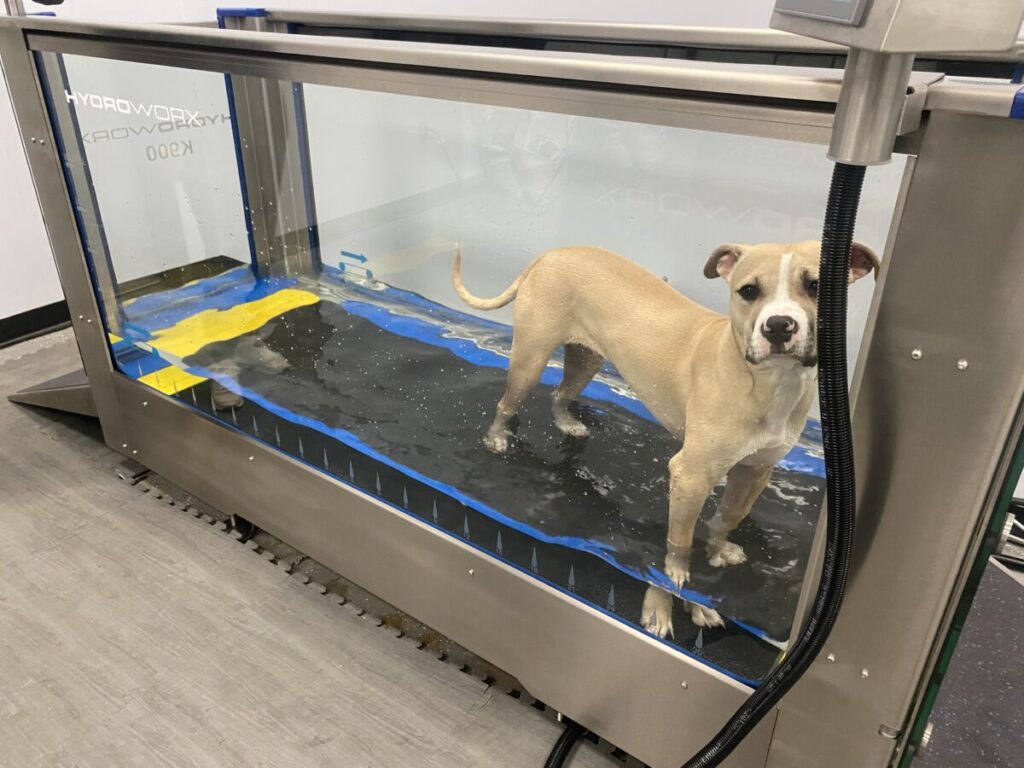10 Trends in Veterinary Rehabilitation
Pre-hab, Hydrotherapy, Laser Therapy, and More
Canine rehabilitation is a fast-growing segment of veterinary medicine. One of the key driving factors for growth is that pets are increasingly viewed as family members. If your family member has surgery, their next stage of care is physical rehabilitation–why should it be any different for pets?
Just like with humans, rehabilitation is not just for post-surgical care.
Veterinary Rehabilitation Trends
#1 Pre-hab and Preventive Care
The best intervention is early–or preventive. Veterinary rehabilitation can effectively strengthen problem areas which can allow pets to avoid or delay surgical procedures. Pre-hab is also used to reduce strain on joints through mobility-increasing exercises, and weight loss programs. In some cases pets benefit from exercising in underwater treadmills to reduce the strain on their joints allowing them to shed pounds in a more comfortable environment.
#2 Hydrotherapy
Hydrotherapy has grown in popularity in veterinary medicine over the past decade. Underwater treadmills are very versatile pieces of rehabilitation equipment allowing veterinarians to offer options for both recovery and conditioning.
- Low-Impact: Underwater treadmills create a low-impact environment that provides a safe option for post-operative rehabilitation and for exercise. Pets with chronic pain or joint issues can move with ease because the water reduces the weight-bearing load on joints.
- Athletes: Conversely, the water height may be raised, and the incline and treadmill speed increased to create a challenging exercise environment for canine athletes who are training for competition.
- Cold Weather: Some clinics offer membership programs to pet owners during cold-weather months in geographies where the winter is harsh. This option can stabilize winter revenue, and provides a fun exercise option for pets. These exercise programs are also effectively introducing pet owners to hydrotherapy as a rehabilitation option if their pet ever needs it.

#3 Modalities
Just like human rehabilitation, veterinary rehabilitation specialists leverage modalities. There are 5 emerging technologies that are helping veterinarians level-up their rehabilitation services:
- Laser Therapy: Often referred to as photobiomodulation (PBM), laser therapy targets damaged tissue to support healing on a cellular level. Many practitioners administer laser therapy before rehabilitation sessions because of its ability to reduce pain and increase mobility–allowing them to get more out of rehabilitation visits. Laser therapy is painless and non-invasive. PBM is commonly used in a multi-modal plan of care that may also include NSAIDs and physical rehabilitation.
- Gait Analysis: These systems allow veterinarians to pin-point gait abnormalities and track changes while pets are actively engaged in physical rehabilitation programs.
- Braces: Custom braces and orthopedic support devices can provide pets a little extra help.
- Electrical Stimulation: Veterinarians utilize e-stim to strengthen muscles through the use of electrical currents.
- Hydrotherapy: Hydrotherapy allows veterinarians to customize rehabilitation and conditioning programs by adjusting underwater treadmill incline, speed, and water height.
- Shockwave Therapy: Shockwave therapy utilizes acoustic waves to stimulate tissue and promote healing.
#4 Canine Athletes
Canine athletes benefit from physical rehabilitation both before and after sport. Veterinarians are leveraging hydrotherapy to create challenging exercise routines to prepare athletes for competition. After competing, a multi-modal approach to physical rehabilitation is used to support tissue recovery and help with muscle soreness and inflammation.

#5 Rehabilitation–for All!
It is a common misconception that physical rehabilitation is just for dogs. A wide range of pets can benefit from rehabilitation including cats, birds, and exotic pets. Pet ownership is on the rise across the board and many veterinarians are searching for ways to expand their rehabilitation services to support a wider range of species.
#6 Acupuncture
Rehabilitation practitioners offer acupuncture as another non-invasive tool in the rehabilitation toolkit. Acupuncture is well tolerated by pets and can be combined with a multi-modal approach to care.
#7 Supplements
Joint supplements can ease pain and increase mobility–making rehabilitation sessions more productive.
#8 A Focus on Controlling Pain
While pain management has always been important, it’s become a hotter conversation topic in recent years. As pets have become regarded as family members the topic of pain management has increased. Rehabilitation has become commonplace as a first step to pain management to avoid surgery and more invasive procedures.
#9 Long-Term Mobility
Pets are living longer and pet owners are more concerned about long-term mobility and quality of life after surgical procedures. This trend has supported the growth of veterinary rehabilitation services across the country.
#10 Rehabilitation Services in General Practices
As veterinary rehabilitation has grown–so has its prevalence in general veterinary practice. Many clinics are creating rehabilitation programs to meet the growing demand for post-surgical rehabilitation and preventive services.
A Bright Future for Veterinary Rehabilitation
The combination of rising pet ownership with the regard for pets as family members promises to continue to encourage the growth of veterinary rehabilitation services.
Contact us to discuss the benefits of adding veterinary rehabilitation services to your practice.

